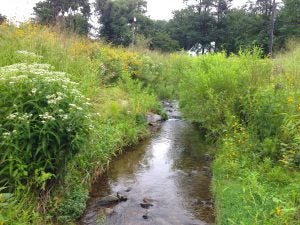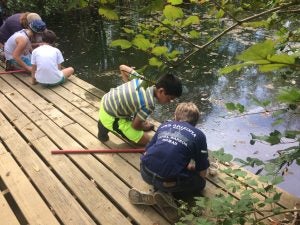Cultivating future generations of water stewards in Delaware River watershed
Carrying out the legacy of clean water in the Brandywine and Red Clay Creek watersheds falls on the next generation of water stewards.
Because change comes slowly when it comes to cleaning rivers and streams, it’s up to the next generation to carry on the legacy of water stewardship in the Brandywine and Red Clay Creek Watersheds.
The West Chester-based Brandywine Red Clay Alliance (BRC) has fought to protect the Brandywine Creek and the Red Clay Creek for 72 years. In 1945, the Brandywine Valley Association (BVA) was formed, the oldest small watershed organization in the country. Seven years later, the Red Clay Valley Association (RCVA) was founded. Both watershed organizations merged in 2015 to redouble their efforts.
Stream restoration is a big part of the organization’s work. For the last four years, the BRC has received grant money from the William Penn Foundation as part of its Delaware River watershed restoration initiative.
BRC Watershed Conservation Director Bob Struble said the grant money has been used directly to fund stream restoration. About $4 million has been invested in 15 projects since 2010. One of those projects, was the restoration of Plum Run, a 3.5 square mile watershed just outside of West Chester.

The long-studied stream there recently received $500,000 worth of improvements. Stormwater runoff, erosion and sediment in the water were chief among its problems.
“Plum Run was in what we would call an impaired condition,” Struble said. “The sediment is a problem because it covers up the rocks in the stream. The rocks are the places where the insects, what we call macroinvertebrates, will nest. The insects are important because the fish eat the insects and if you don’t have good insects, you won’t have the fish you’re looking for.”
Fertilizer elements, nitrogen and phosphorous, were also introduced in the stream, Struble said.
“They start to grow things like algae or other aquatic life in the stream that will take oxygen out of the stream and lower the oxygen levels. That can be harmful to fish and other aquatic life.”
BRC’s work matters to Delaware because the waterways may start in Pennsvlvania, but they flow into the First State.
“Wilmington drinks the Brandywine, Newark drinks the White Clay and the Red Clay,” Struble said. “So if we get things right with those small streams, they will literally flow downstream to the larger ones so it’s incredibly important to work on those small streams and make sure they’re in good condition.”
The 5-year restoration project at Plum Run was completed in 2013. Vertical stream banks were sloped to prevent erosion, a cross vane was put in to channel the water. Native grasses, wildflowers, trees and shrubs were planted.
“One of the things we struggle with is getting the general public to understand that we still have a way to go with improving our water and I don’t think anybody objects to that, but it may not be up near the top of the list anymore and that’s a bit of a struggle for us,” Struble said.
It’s a fight the next generation of water stewards will have to carry on.
Dr. Gerald Kauffman is director of the University of Delaware Water Resources Center. He is teaching that next generation of hydrologists, conservation scientists and green engineers in his watershed management class.
“We look at the engineering of our water resources, we look at the laws, the economics, the society governance structures on how water is managed in Delaware, the Mid-Atlantic and the nation,” Kauffman said.
The U.S. Department of Labor’s Bureau of Labor Statistics started tracking so-called “Green Jobs,” in 2010; results were released in 2013. However, federal budget cuts resulted in the elimination of that program.
That said, the numbers in the Life, Physical and Social Science Occupations group, which includes some green jobs, reflected growth in terms of employment.
In 2000, employment in this group numbered at 1,038,670 with a median income of $43,090. Sixteen years later, employment rose to 1,152,840 with a median income of $63,340.
“We keep track of the graduates and they get really good jobs whether it’s in the public or private sector,” Kauffman said. “Some of them are actually deciding water policy, here in Delaware and also in the EPA, for instance.”
Kauffman said his class has been offered to undergrads and postgrads since 1999 and enrollment has steadily increased year after year.
“Protecting the environment to our current generation that’s gone to university and high school, they see it as a natural thing to do, so I’m encouraged by that. So therefore the rise of environmentalism is just peaking now,” Kauffman said.
While Kauffman teaches the next generation, BRC Education Coordinator Julia Steiner is focused on the generation after that through BRC’s K-12 summer camps and water programs.

“We look at the physical aspects of the site and they’ll notice what’s growing here. The absence or presence of a variety of species of trees. What’s around the pond? Does it have a good buffer, is everything mowed back, does it have shade? These are all important characteristics to a healthy pond,” Steiner explained. “And then they end the program by dip-netting and exploring, we call them water bugs, or macroinvertebrates, and their absence or presence in the water really does give kids a look at holistically the health of the pond.”
Steiner hopes these fun, hands-on activities will plant a seed that will grow into a love for the environment as they grow up, to see efforts, like the stream restoration at Plum Run, through to the end.
Struble said BRC has seen relatively little positive change so far at Plum Run, but that’s not surprising since the restoration was only just completed four years ago. Struble said any positive changes take at least five to 10 years before the public can see the scales move. Hence, Struble, and current water stewards, hope the next generation will continue the legacy of clean water for decades to come.
WHYY is your source for fact-based, in-depth journalism and information. As a nonprofit organization, we rely on financial support from readers like you. Please give today.





